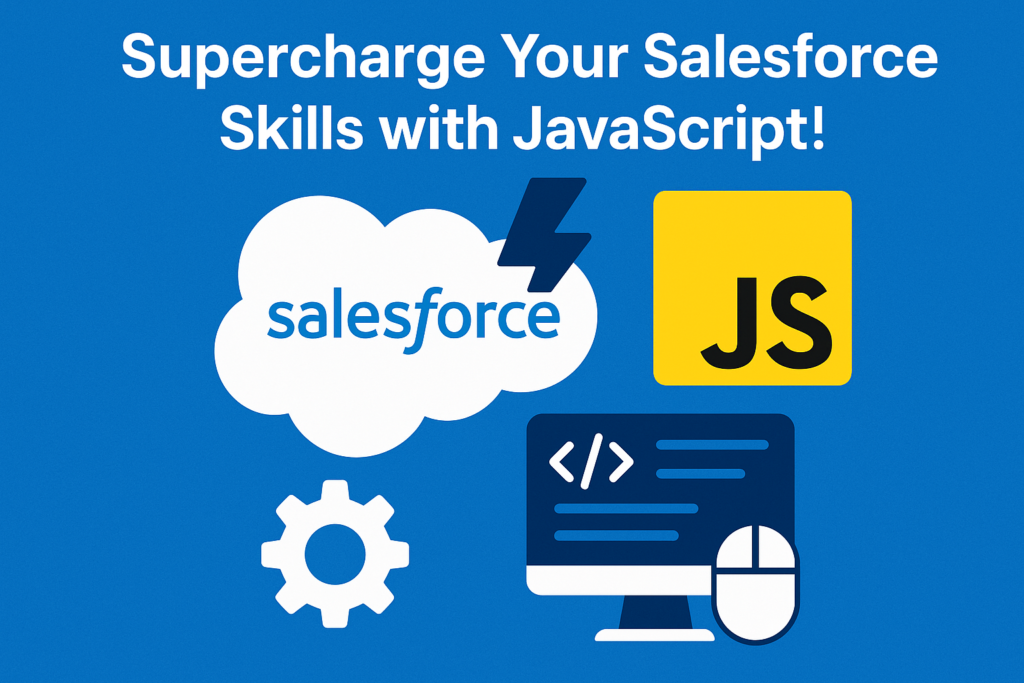⚙️ Supercharge Your Salesforce Skills with JavaScript!
🤔 What Makes JavaScript So Important in Salesforce?
JavaScript is not just a web language — it’s deeply woven into Salesforce’s modern architecture. You’ll find it powering:
✅ Lightning Web Components (LWC)
✅ Aura Components
✅ Visualforce Pages
✅ Custom Buttons & Actions
✅ External Integrations (APIs, Scripts, etc.)
🎯 If you’re aiming to become a Salesforce Developer Rockstar, JavaScript is non-negotiable!
🧩 Real-Life Use Cases: Where JavaScript Shines in Salesforce
💼 Scenario | 💡 How JavaScript Helps
—|—
🧠 User Input Handling | Dynamically validate fields before submission
🚀 Page Interactions | Instantly update UI elements based on user actions
🔌 External API Integration | Fetch live data like weather, currency rates, or 3rd-party info
🧾 Data Display | Sort/filter/search records in real time
🛎️ Event Handling | Trigger logic on clicks, keypresses, or record changes
🛠️ Building a Lightning Web Component (LWC) with JavaScript – A Hands-On Example
📄 helloUser.html
<template>
<lightning-input label=”Enter your name” onchange={handleInput}></lightning-input>
<p>Hello, {name} 👋</p>
</template>
💻 helloUser.js
import { LightningElement, track } from ‘lwc’;
export default class HelloUser extends LightningElement {
@track name = ”;
handleInput(event) {
this.name = event.target.value;
}
}
🧠 Calling Apex Methods with JavaScript – No Page Refresh Needed!
import getAccounts from ‘@salesforce/apex/AccountController.getAccounts’;
connectedCallback() {
getAccounts()
.then(result => {
this.accounts = result;
})
.catch(error => {
console.error(“Error fetching accounts:”, error);
});
}
🌐 Fetch External API Data in Salesforce with JavaScript
async function getWeatherData() {
const response = await fetch(“https://api.weatherapi.com/v1/current.json?q=London”);
const data = await response.json();
console.log(“Current Temp:”, data.current.temp_c);
}
✅ Real-Time Form Validation: A Must-Have!
handleSubmit() {
if (!this.name || this.name.length < 3) {
alert(“Name must be at least 3 characters.”);
return;
}
// Proceed to save data
}
💬 Talk to Other Components Using JavaScript Events
const event = new CustomEvent(‘mycustomevent’, {
detail: { message: “Hello from child!” }
});
this.dispatchEvent(event);
🖼️ DOM Access and Styling: Keep It Dynamic
this.template.querySelector(“.status”).classList.add(“highlight”);
🔐 JavaScript in Visualforce Pages (Old but Gold)
<script>
function validateBeforeSubmit() {
const name = document.getElementById(“nameField”).value;
if (!name) {
alert(“Please enter a name!”);
return false;
}
return true;
}
</script>
🧑💻 Salesforce JS Best Practices (That You *Shouldn’t* Skip!)
🟢 Prefer `let` and `const` over `var`
🟢 Keep logic modular — break large code into smaller functions
🟢 Avoid direct DOM manipulation unless absolutely necessary
🟢 Comment smartly and clearly
🟢 Always test for error conditions using `try…catch`
🧰 Must-Have Tools for JavaScript Devs in Salesforce
🧪 Tool | 🛠️ Purpose
—|—
VS Code + Salesforce Extensions | Autocomplete, deployments, debugging
Salesforce CLI | Fast deployment and scratch org creation
Chrome DevTools | Inspect LWC performance and DOM
LWC Playground | Try and share LWC code online
SLDS Styling | Keep UI native and clean
🎯 Final Takeaway: JavaScript is the Secret to Salesforce Magic ✨
💬 Still think JavaScript is just for web apps?
In Salesforce, it’s your gateway to performance, interactivity, and next-level UX.
“In the world of Salesforce, JavaScript is not optional — it’s your UI wand.” 🪄
From a small validation script to a full-scale component, JavaScript brings your ideas to life.
🚀 So go ahead — type some code, debug a component, call an Apex method — and start building with confidence!

